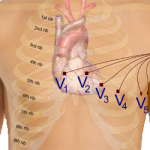What is Telemetry
Individuals who work in the healthcare sector as an EKG technician or cardiac technologist are required to monitor heart disease patients through the use of telemetry. Those who are not familiar with this unique device and who find themselves asking, what is telemetry, can benefit from a basic understanding of how the technology came about and its uses in other industries. This approach will allow technicians to develop a more informed perspective of the services that they provide while ensuring the safety and well-being of patients.
What is Telemetry
In the simplest terms, telemetry is the transmission of data from sources that are difficult to connect to a monitoring device. The communication that occurs between data collection devices and monitoring devices is often wireless, but may involve computer and mobile network connections. Telemeters are used to receive transmitted data and often include a sensor along with a display. Some equipment may also incorporate … Click Here to Continue Reading

12 Lead EKG
The 12 lead EKG is a widely accepted medical standard for electrocardiogram administration in healthcare facilities across the United States and around the World. While the term ‘lead’ is often used loosely to refer to the cables that are attached to the body through which signals are transmitted to the monitoring device, it actually references the tracings that result due to voltage differentials. This can become a bit confusing considering that it is common to use ten cables to conduct a 12 lead EKG. The lead placement has been standardized in the US.
Electrode Number and Placement
The standard electrocardiogram uses ten cables that are connected to different parts of the patient’s body via a gel that conducts electricity and an adhesive pad. There is an electrode for the right arm (RA), left arm (LA), right leg (RL), left leg (LL), 2 for the fourth intercostal space on either side of the sternum … Click Here to Continue Reading
EKG Rhythms
The electrocardiogram (EKG) is an important tool that is used to evaluate heart health. The technician is responsible for the administration of the exam and needs a basic understanding of EKG rhythms to determine whether or not the exam has been completed properly and to perform an initial evaluation of the results. Individuals who put forth the effort to learn about the different types of rhythms and what they mean will discover that they enjoy higher levels of career satisfaction and are in a better position to provide comprehensive care.
A standard electrocardiogram is administered using cables that are commonly referred to as ‘leads.’ The leads are designed to detect voltage differences between electrodes and transmit information to the recorder so that a visual representation of the differences can be created. The typical 12-lead EKG uses ten electrodes that include RA, LA, RL, LL, V1, V2, V3, V4, V5, and V6. Additional leads … Click Here to Continue Reading





